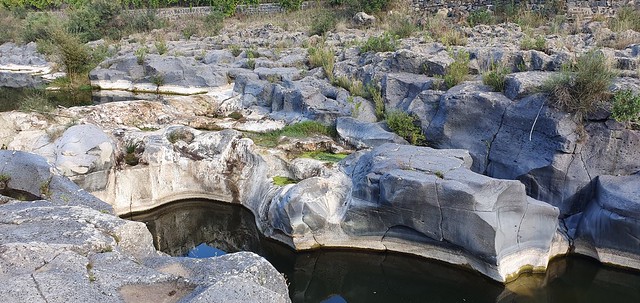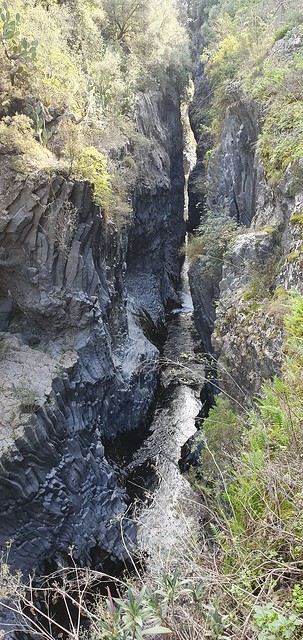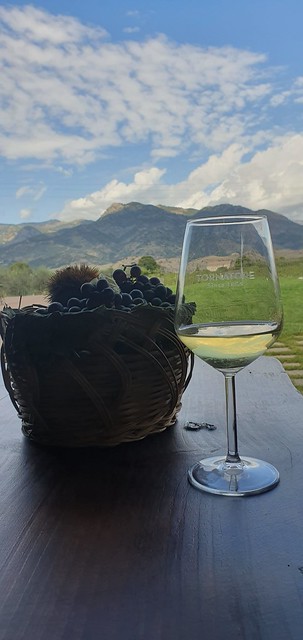By far the most striking natural feature along Sicily’s Ionian coast is the towering volcanic peak of Mt. Etna Which spews ash and steam more or less continuously from its crater. The mountain and its roughly 570,000 years of activity have left an indelible impression on the surrounding landscape, beginning with the mountain slopes and valleys blanketed with rich volcanic soil that today produce excellent wines, Sicily’s most prestigious pistachios, blood oranges, and a number of other specialties.

(Photo by CIU Travel via Flickr)
Another impressive consequence of Etna’s millennia of activity are the the Alcantara Gorges—or Gole dell’Alcantara in Italian—that sit at the foot of the mountain’s northern slope. This network of vertiginous gorges cutting through the volcanic rock were formed by the Alcantara River, which runs from the Nebrodi Mountains to the coast near Giardini Naxos. The rushing river waters follow the path of an ancient lava flow, carving dramatic open-air ravines and underground passages through the hardened lava stone along the way.
The gorges, including some more than 200 feet deep, are part of the Alcantara River Park, known for its picturesque black lava rock formations and river rapids. The river divides the park between zone A on the southern bank on the Etna side of the river and zone C on the northern bank towards the valley; zone A is a pristine, protected area and zone C allows for development, meaning that it has become crowded with tour bus visitors and a rather off-putting clutch of kitschy souvenir huts and bars.

(Photo by CIU Travel via Flickr)
Though the northern bank is more accessible, with an elevator that takes visitors from street level to the floor of the gorge and a riverside cafè, the best way to enjoy the gorge is by approaching from the wilder and more picturesque southern bank, protected via its zone A designation and only accessible with a licensed guide or outfitter.
A visit to the Gole dell’Alcantera can include anything from a simple guided walk through the park along the upper ridge of the gorge to a more challenging hike down into the canyons. Adrenaline junkies can try their hand at canyoning down the sheer rock faces or body surfing down the rapids; outfitters provide one or more trained guides, equipment from hiking boots to wet suits, and expert commentary on the geology and flora of the area. Most outfitters also offer family-friendly adventures that take on lower canyon walls and gentler rapids that are a fun day out for kids.

(Photo by CIU Travel via Flickr)
The gorges are close enough to Etna’s peak that adventurous travelers can make a day of it, pairing an excursion up the mountain with a hike or canyoning excursion along the Alcantara River. The northern slopes of Etna are rapidly becoming known for their small wineries, and breaking up the day with a wine tasting lunch is a great way to relax before or after your visit to the park.

(Photo by CIU Travel via Flickr)
Tips for visiting the Alcantara River Park
Wear sturdy footwear, sun hat, sunscreen, and sunglasses to explore the gorges. Outfitters will provide any technical gear you may need and let you know ahead of time what you’ll need to bring.
There is an entrance fee for the Alcantara River Park for those entering from the southern bank. If you are joining a guided hike or adventure with an outfitter, entrance to the park is generally included.
Most guides and outfitters offer kid-friendly hikes and adventures that are appropriate for elementary school ages and up. Hiking and canyoning in the gorges is not recommended for very young children or those who are not in good physical condition.
If pairing your visit with an excursion to the top of Mt. Etna, climb the volcano in the morning when the air is clearer for photos and take on the river in the afternoon, when the cool water is a welcome respite from Sicily’s summer heat.


